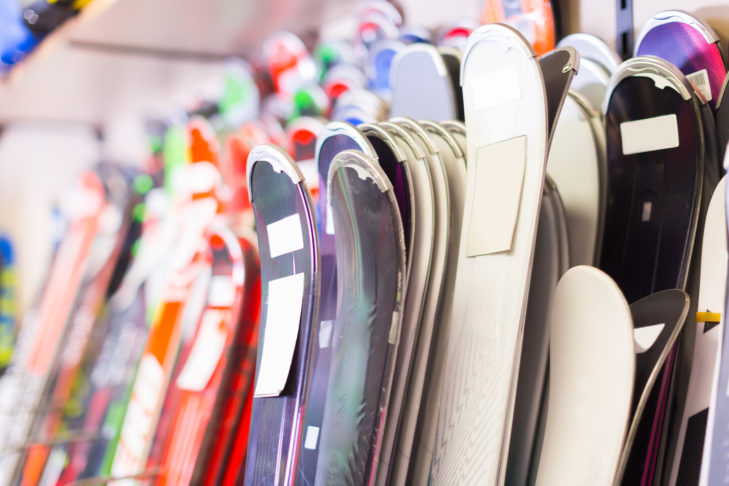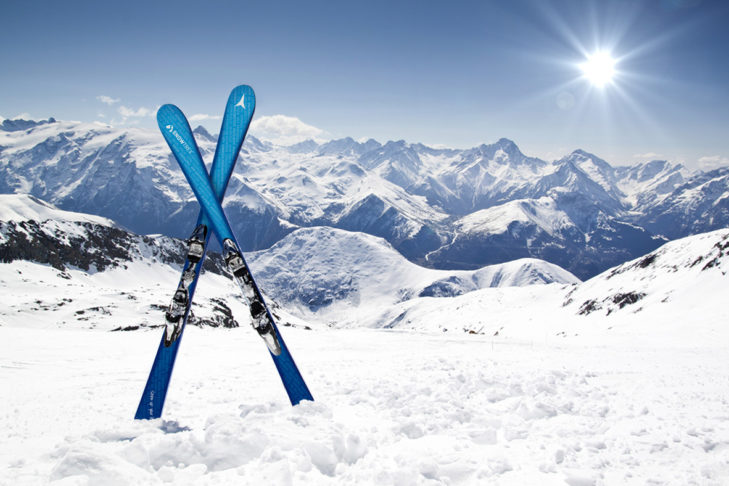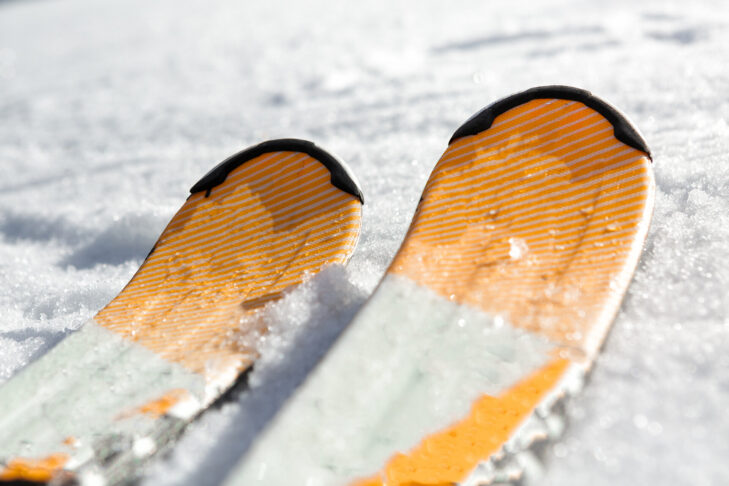Since the rise of the rocker ski a few years ago, ever more piste products have been developed to meet the needs of different skiers. Depending on radius, edge grip, or the ratio of piste to powder skiing, various types of skis are categorised according to different models. With such a wide range of options, it can sometimes be difficult to keep track. To help winter sports enthusiasts choose the right skis before their first descent, SnowTrex presents many types of skis and explains how they are constructed.
Overwiew of ski types
| Ski Model | Ski Level | Terrain |
|---|---|---|
| Allround Carver / Sport Carver | Beginners & Leisure Skiers | Piste |
| Allmountain Ski | All levels, especially good piste skiers with occasional off-piste runs | Piste & Off-Piste |
| Slalom Carver | Experienced skiers with precise technique | Piste |
| Lady Ski | Specifically designed for female skiers of all levels | Piste |
| Race Carver | Extreme sporty skiers | Piste |
| Freeride Carver | Powder & off-piste skiers | Off-Piste |
| Freestyle Ski | Snowpark- & trick skiing fans | Piste & SnowPark |
| Tourenski | Skitourers | Off-Piste |
Which ski is right for me?
The Outdoor retail Evo are helping undecided winter sports enthusiasts get on the right track when buying skis:
Please also note that by using our services and integrating the YouTube API Services, the YouTube Terms of Service and the YouTube API Services Terms apply and your use of our website is deemed to be acceptance of these terms.
All ski models in detail
All-round carver
The all-rounder is a standard ski, generally between 165 and 180 centimetres in length, and is especially suitable for beginners or leisure skiers. With gentle sidecut, this model allows both skidded and carved turns. These skis are easy to turn, have a relatively low weight, and are forgiving of mistakes. Another argument for their great popularity is the purchase price, which on average is significantly lower than that of more specialised models. The waist width of all-rounders ranges between 72 and 76 millimetres, and the ski length should be about 10 to 20 centimetres shorter than the skier’s height.
Conclusion: The choice for beginners and leisure skiers!
All-mountain ski
The name says it all: all-mountain skis feel at home everywhere. With a firm edge, they perform well on relatively hard pistes, yet thanks to their softer core, they can also be ridden in powder snow. Their waist width, at around 85 millimetres, is wider than that of all-rounders, but still allows for smooth carving on the piste. The most common all-mountain skis are designed for 70% on-piste and 30% off-piste use. However, there are also more specialised “Performance” and “Free” lines whose areas of use are more heavily focused either on piste or off piste.
Conclusion: Perfect for good skiers who also like to venture off piste!
Slalom carver
With these sharp-edged skis, generally between 155 and 170 centimetres in length, true piste experts carve every turn with precision. Slalom carvers are lively skis designed for short, quick turns with high frequency. With a waist width of 63 millimetres, they achieve a radius of 12 to 13 metres. These are the only skis sometimes built without a rocker, i.e., without reverse camber, which means they can also be ridden shorter. The rule of thumb for length here is: body height minus 20 centimetres.
Conclusion: Ideal for experienced skiers with precise technique who like to ride fast on hard pistes!
Race carver
The sportier version of the slalom ski is the giant slalom ski, also known as the race carver. These long skis are true World Cup models. Thanks to their larger radius, stiffer flex, and razor-sharp edge grip, they are designed primarily for professionals. Ranging from 170 to 185 centimetres in length, these skis require not only tremendous leg strength but also plenty of space on the piste, as their dynamic high-speed turns reach radii of up to 20 metres. The recommended length for race carvers is roughly equal to the skier’s height.
Conclusion: The right choice for athletic racers seeking a ski with perfect tracking!
Touring skis
Touring skis must meet various requirements for both steep ascents and the subsequent off-piste descents. They should be relatively light for the climb, which is why they are built from special materials and sometimes feature minimalist binding systems. Despite their lightness, these different types of touring skis must remain controllable during descents in the terrain, which is why they often have wide waists and rocker constructions. Depending on the intended use, there are touring skis designed specifically for the climb or primarily for a safe descent. This should be taken into account when buying skis, as the recommended length also varies accordingly.
Conclusion: A must for nature-loving powder skiers!
Freeride ski
The widest skis are the freeride models. They need to float well in powder snow while offering stability. Their waist can be up to 130 millimetres wide, with the tip and tail rockered up to 50% of the ski’s length. Thanks to the strong rocker and broad surface area, these skis provide excellent lift in deep snow. They have minimal sidecut and are therefore relatively heavy. Strong legs and solid off-piste technique are required to handle them. As a rule of thumb, the correct length is up to 5 centimetres longer than the skier’s height, depending, of course, on body weight and skill level.
Conclusion: Experienced powder fans and confident off-piste riders can’t go wrong here!
Freestyle ski
Freestyle skis are trick skis designed for playful riding in the snow park and on the piste. Their special feature is the so-called twin tip, where both the tip and tail are upturned similarly – in some models even identically. This makes it easy to ski backwards as well. These skis are highly manoeuvrable yet torsionally stiff enough to withstand the impact of jumps and tricks in the snow park. They are lively to ride and are usually chosen in shorter lengths – about 5 centimetres less than the skier’s height.
Conclusion: A must for playful freestylers and snow park riders!
Lady ski
Almost all ski types are also available in women’s versions. These models have the same performance characteristics as the men’s but are adapted to the female physique by using different materials in some areas, making them overall lighter. The binding is also positioned slightly further forward to allow for better control with lower body weight and height. In addition, great emphasis is placed on design and aesthetics in women’s skis. The ideal length for women’s models, depending on weight and ability, is roughly the skier’s height plus or minus 5 centimetres.
Conclusion: Ideal for sporty women with varied requirements for a perfect day on the slopes!
What makes a ski a ski?
Rocker
Alpine skis are generally under tension, meaning that when winter sports enthusiasts don’t strap them to their feet, the skis never lie completely flat on the snow. Due to this camber, there is always a gap under the binding. In the early 2000s, ski manufacturers gradually introduced models with negative camber, known as rockers. On these skis, the tips and sometimes the tails are bent upwards. This extra bend can be placed at one or more points on the ski. Skis with an additionally upturned tip are called tip rockers. This construction is now standard in most all-round or all-mountain rocker models, which at first glance differ little from normal carving skis.
In contrast, full rockers are easy to spot. They are strongly bent upwards at both the tip and the tail, and they are also wide and long. Winter sports enthusiasts mainly use these models in powder snow. This is where the rocker originated – they were initially developed for freeride skiing, as their negative camber provides better control in deep, fluffy snow.
Stiffness
The stiffness of a ski is determined by two parameters: flex and torsion. Flex refers to the stiffness along the ski’s length – how much it bends when weight and speed put pressure on it. A stiff flex offers more control and a smoother ride, while a softer flex allows for more agile turns. Torsion refers to stiffness along the longitudinal axis – the angle at which the ski tilts onto the snow when edged. Soft torsion doesn’t edge as aggressively as hard torsion, which forgives more mistakes. The optimal stiffness depends on the skier’s body weight, skill level, and preferences.
Base
The ski base is the bottom part of the ski that comes into contact with the snow while skiing. That’s why it’s important to keep it well waxed. A waxed ski glides more smoothly and is better protected. Typically, the base is made from polyethylene plastics, which, depending on their composition, give the ski different properties. The base material can influence, among other things, how fast the ski is and how much wax it can absorb.
In total, winter sports enthusiasts can choose from three different types of wax. Leisure skiers who prefer a relaxed day on the slopes in perfect weather should have cold wax applied to their skis before the start of their holiday. This product is a true all-rounder, quick to apply and effective in all weather conditions without major performance losses. Ski pros and advanced skiers, who might even have several pairs of skis for different slope conditions in their cellar, face a choice when it comes to waxing. On the one hand, there’s high-fluor wax, which makes skis glide better in wet, slushy snow at warmer temperatures. On the other hand, there’s low-fluor wax, which performs best at low temperatures and on dry powder snow.
EVO shows in a video how professionals wax different ski types:
Please also note that by using our services and integrating the YouTube API Services, the YouTube Terms of Service and the YouTube API Services Terms apply and your use of our website is deemed to be acceptance of these terms.
Edges
Ski edges are made of metal, usually steel, and run along the ski’s sides. Side edges are ground at a specific angle, usually between 88° and 90° to the base, depending on the ski’s intended use. The angle greatly influences handling – a shallower angle makes the ski harder to control. Skiers should have their edges sharpened regularly.
Sidecut radius
If you look closely at the side edge of the ski, you will see that skis are narrower in the middle than at the tip and tail. The edge follows this shape on the outside of the various ski types, forming almost a circular arc. This is specified with a certain radius, the construction radius. In practice, this means that when the ski is edged, it turns in exactly this radius. Depending on the type of ski, the skis can have different construction radii. This means that if the construction radius is smaller, winter sports enthusiasts can also make tighter turns. With a larger radius, the turns that are possible when skiing are wider.
| Radius (in m) | Ski type | Description |
|---|---|---|
| 10 to 12 | Slalom | These skis can make small, aggressive turns. |
| 14 to 20 | Freestyle, Beginner, All-round, Powder | Most skis fall within this range. The larger radius gives them more stability at higher speeds, making them suitable for most speeds and slopes. |
| 20 to 30 | Giant Slalom, Freestyle, Powder | Since Giant Slalom involves higher speeds and wider turns, the radius must be larger. Freestyle skis and powder skis also often have larger radii, as they are not designed for quick, aggressive turns. |
| 30+ | Racer | Skis with a radius of 30 meters or more are almost exclusively intended for racers who ski at extremely high speeds. For most slopes, such wide turns would be too dangerous. |
Not only the edge angle and radius but also the sharpness matters – sharp edges bite into the snow better, improving stability and glide.
Width
A ski can be built wider or narrower. This affects how the ski glides through the snow and how much pressure skiers can exert on the edges. Skis for powder snow, for example, are wider. The larger surface area exerts less pressure on the soft snow, giving the ski more buoyancy and allowing it to glide better. At the same time, however, a wider ski also makes edging more difficult. The general trend is therefore towards building all-purpose skis that are wide enough to be suitable for both groomed slopes and off-piste skiing.
Length
The right ski length depends on the ski type and the skier’s height. Longer skis offer more control at high speeds but reduce agility.
Weight
Heavier skis provide more control but are harder to manoeuvre. Beginners and freestylers often use lighter skis for agility, while racers prefer heavier skis for stability at speed.
Tips
Traditionally, ski tips (the shovel) are more curved than the tails, making it easier to ride over bumps. In freestyle skiing, twin-tips (curved at both ends) are common, allowing skiers to ride fakie (backwards).
How do I care for my skis?
During a fast-paced day on the slopes, skis are exposed to various extremes: cold, moisture, sunlight, impacts, or road salt. This makes it essential for every winter sports enthusiast to take care of their equipment—whether it’s used only a few days per season or for several weeks. If you want your skis to last, you should not only clean them after the last run of the day. At the end of the season, there are also measures you can take to ensure they “summer” well and are ready for use in the next winter. To be on the safe side, SnowTrex has researched the topic of storing and maintaining skis.
FAQ’s about skis
Which ski is right for me?
There is certainly a right ski for every skier. Finding it depends on factors such as skill level, skiing style, and personal preferences. To choose the right model, it helps to have a solid knowledge of ski types and features.
What types of skis are there?
Today, the range of established manufacturers for classic skis with metal edges can be divided into eight categories: all-mountain skis, all-round carvers, freeride carvers, freestyle skis, ladies’ skis, race carvers, slalom carvers, and touring skis.
Which skis are easier to handle?
All-round carvers are the easiest to handle. They are lighter than many other models and also more forgiving of mistakes. They are ideal for leisurely skiers who enjoy making relaxed turns on blue slopes in sunny weather.
What ski length is right for me?
Ski length is always determined by the skier’s height. The only exception is race carvers, where the rule of thumb is that the skis should be the same length as the skier’s height for optimal performance. Freeride skis should be about five centimetres longer than the skier. The same applies to ladies’ skis, although depending on the skier’s skill level, they can also be up to five centimetres shorter—just like freestyle skis. In comparison to body height, less length is recommended for touring skis (10 to 15 cm shorter), all-round carvers and all-mountain skis (10 to 20 cm shorter), as well as slalom carvers (20 cm shorter).
Which skis are suitable for the slopes?
Basically, any ski that meets quality and safety standards can be used on groomed slopes. However, specifically designed for piste skiing are all-round carvers, all-mountain skis, slalom and race carvers, ladies’ skis, and freestyle skis.
What is the difference between touring skis and alpine skis?
Unlike alpine skis, touring skis are softer and therefore lighter in construction, mainly for weight reasons. The same applies to ski bindings. The reason for this is that ski tourers initially climb the mountain using pure muscle power. However, because the route literally leads over hill and dale, the base of touring skis is significantly harder and therefore more resistant. This type of ski also has a wider tip to create more surface area for greater buoyancy in deep snow.
Which skis can be used off-piste?
Not all skis are suitable for off-piste skiing in powdery deep snow due to their width. Freeride carvers are specially designed for this terrain. Touring skis are also ideal for ascents and descents in unprepared terrain. Winter sports enthusiasts can also enjoy a pleasant skiing experience off-piste with all-mountain skis.
Which skis should beginners choose?
The ski that beginners should try first is the all-round carver. This is a standard ski that is designed to be suitable for beginners. Models of this type of ski are easy to turn on the slopes and, thanks to their less radical shape, allow for both sliding and carved turns.







